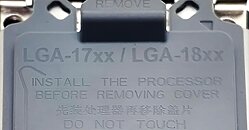
Intel LGA1700 Socket Pictured, Familiar Installation Method
Here's the first picture of Intel's upcoming mainstream desktop processor socket, the LGA1700, which was until now only seen in renders or technical drawings. The socket is characterized by a more rectangular contact pad than previous Intel sockets. The Socket H family (LGA115x and LGA1200) that ruled Intel MSDT sockets for over a decade, has a largely square pad. Intel's HEDT sockets such as the LGA1366, LGA2011 and LGA2066, on the other hand, had a rectangular pad, though not as pronounced (slender) as the LGA1700.
From the looks of it, the retention mechanism of the LGA1700 appears similar to that of Socket H and most other Intel LGA sockets (though dissimilar from the LGA2011/LGA2066). In its client desktop avatar, the LGA1700 has 100 unused pins. This is because the socket is physically identical to the LGA1800, which is speculated to be left for future generations of Intel processors with additional power or I/O pins. The Z-height of LGA1700 is lower than that of Socket H, which entails a major change in the retention module design of most aftermarket CPU cooling solutions.
From the looks of it, the retention mechanism of the LGA1700 appears similar to that of Socket H and most other Intel LGA sockets (though dissimilar from the LGA2011/LGA2066). In its client desktop avatar, the LGA1700 has 100 unused pins. This is because the socket is physically identical to the LGA1800, which is speculated to be left for future generations of Intel processors with additional power or I/O pins. The Z-height of LGA1700 is lower than that of Socket H, which entails a major change in the retention module design of most aftermarket CPU cooling solutions.


